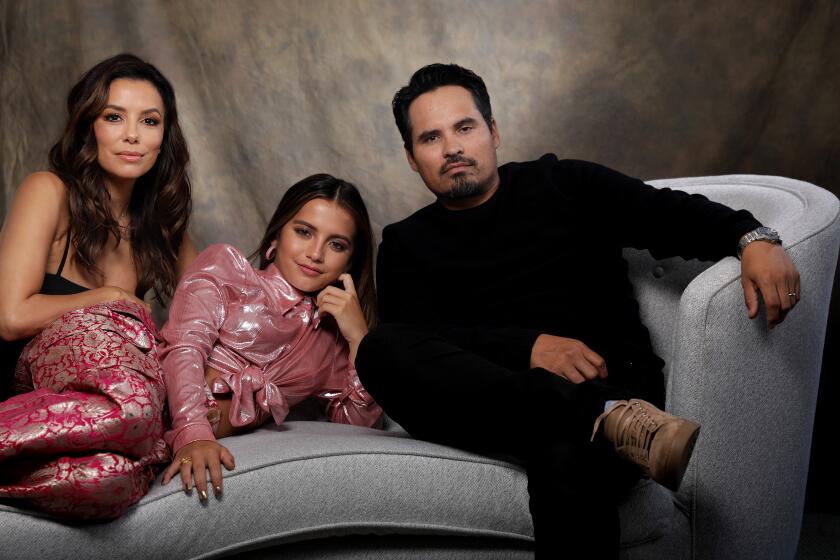Latino representation in Hollywood movies is abysmal. Here’s the proof
- Share via
While the past few years have been dominated by the narrative that diversity and inclusion on television and in film are moving in a positive direction, a new study from USC Annenberg Inclusion Initiative has found that for Latinos, underrepresentation and stereotypical portrayals remain firmly in place.
Additionally, on the rare occasions when Latinx characters are depicted in major Hollywood movies, it is rarer still that their cultural and ethnic heritage is explored onscreen.
The study found that among 1,200 popular films released between 2007 and 2018 (a sample of the top 100 films per year), just 4.5% of more than 47,000 speaking or named roles went to Latinx actors. Only 3% were lead or co-leads.
The findings are particularly stark considering the fact that 77% of U.S. states and territories have a Latinx population larger than the percentage seen in major Hollywood films.
“No matter which part of the film ecosystem we examined, Latinos were vastly underrepresented,” said Stacy L. Smith, founder and director of the Annenberg Inclusion Initiative and co-author of the report. “At a time where Latinos in our country are facing intense concerns over their safety, we urgently need to see the Latino community authentically and accurately represented throughout entertainment.”
President Trump calls Latinos “invaders.” Culture could offer a counter narrative—yet it does not.
Behind the camera, the statistics were just as bad. Of the 1,200 films examined, just 4% were made by Latinx directors. Of those, 71% hailed from outside the U.S. and 29% of them were American. Just one director of the 1,335 studied was Latina. (Latinx is a gender-neutral alternative to Latino or Latina.)
Among producers, just 3% were Latinx, with the majority being men — only 19 of them were Latina. Latinx casting directors were also rare. The few films that do have Latinx directors, producers and casting directors also have greater representation of Latinx characters on screen.
“The Latino community has not been prioritized and it is imperative that we shed light on the glaring reality of Latino representation in film,” said Benjamin Lopez, executive director of the National Assn. of Latino Independent Producers. “Dr. Smith’s research must guide decision-makers to the conclusion that there is immense value in collaborating with and investing in the Latino community.”
Stereotypical portrayals of the Latinx community also abound. Across 200 films examined, approximately 25% of Latinx speaking characters were depicted as criminals and 17% were portrayed as poor or low income. Thirty-six percent of all Latinx speaking characters and 60% of top-billed Latinx actors were depicted separately from a larger Latinx community, which translates to a lack of cultural artifacts, traditions and other signifiers that might showcase the characters’ ethnicity.
“The erasure of the Latino community in film creates a void that has been allowed to be filled by hateful and violent rhetoric,” said Mauricio Mota, co-president of Wise Entertainment, an indie studio that services Latinx stories. “It is imperative that the talented storytellers from our community are given opportunities to tell the diverse and vibrant narratives of the Latino audience.”
In Paramount’s live-action “Dora the Explorer” film, five lead actors are of Latino descent. Director James Bobin and stars Isabela Moner, Eva Longoria, Michael Peña and Eugenio Derbez discuss the character’s big-screen debut with “Dora and the Lost City of Gold.”
Although roughly half of Latinx leads or co-leads were women, five of the 17 lead actress roles in the films studied were played by Cameron Diaz. None of the films she starred in hinted at her Latinx heritage.
Of the 100 top-grossing films of 2018, 47 completely lacked a speaking or named character of Latino descent, and 70 lacked Latinas completely. In fact, 568 of the 1,200 movies studied did not feature even one Latinx character and 828 completely lacked Latinas. Additionally, 95 of the top 100 films of 2019 did not feature a Latinx character with a disability and 98 were absent of Latinx characters from the LGBTQ community.
USC Annenberg expects to release its fuller annual report examining diversity and inequality in Hollywood’s on screen portrayals soon.
Los latinos todavía están lamentablemente subrepresentados en Hollywood, y las principales representaciones de películas siguen siendo raras y estereotipadas, según un estudio de la USC
More to Read
Only good movies
Get the Indie Focus newsletter, Mark Olsen's weekly guide to the world of cinema.
You may occasionally receive promotional content from the Los Angeles Times.













